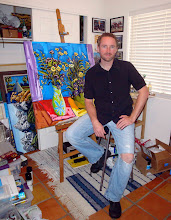
This week I am busy working on a vertical study of a large Saguaro cactus that I found near the Romero Ruins at Catalina State Park. I spent most of yesterday wrestling with the background of reddish ochre colours, all the while trying to do something with the texture and shape of the paint - and, at the same time, trying also to create something spontaneous in shape and form. I have noticed that the shapes you see in nature follow very loose patterns, and it is rare that you see straight lines or predictable angles. Rather, if you are an interpretive artist like I am, then your hand must be somewhat loose in order to create the fluid forms of nature. It is a tight balance between control and non-control.
I have tried for several years now to capture the special quality of our Giant Saguaros of the Sonoran Desert. They are really a local icon of our landscape - large, powerful plants and loom in anthropomorphic shapes all around our hills and flatlands. One thing that I have done that many artists seem to rarely try is that I have done countless works which were studies of the Saguaros themselves - rather than the more popular tactic of merely featuring the Saguaro in a larger landscape. Of course it is always in a larger landscape, but I believe that they are amazing when viewed in small groups together, or alone in one single, large canvas rendition. They are imbued with every variation of light that our desert has to offer. We see the progression of the day as it moves across the creased shapes of the Saguaros, and the eerie shadows that they cast onto the dusty ground. To me they stand alone as an object in our ecosystem that is worthy of individual study.
Another thing I do that may be considered unusual is that when I go out in search of images that I want to turn into paintings, I always look for Saguaros that are unusual in their shape or fundamental characteristics. Southwestern artists seem often to just stylize the Saguaro into a neat, easy to digest shape, with perfect arms and predictable qualities. The truth is actually that Saguaros are radical in their differences, and it is that quality that I love to explore. Some of them grow straight up and have no arms - and I believe that these are referred to as "pole" Saguaros. Some only sprout arms high up on their central trunks. Some sprout arms 1 inch above the ground. Some are partially dead and decaying, but still standing. And some of the most amazing ones are what are referred to as "crested" saguaros, where the top of the saguaro fans out into a creased fan-like shape. This is extremely rare. Among the stands of Saguaros that I commonly visit, there are only 3 that I know of. One of them is on Ina Road in Tucson, and I've painted it - the painting is at Wild Holly Gallery in Carefree, AZ.
Some people still pick on me because I have an easterner's habit of saying the word "Saguaro" with a hard "g", like "Sa-Gwaro", when the local habit is to say "sa-Waro". (I did some Internet research and one site said that the modern word "Saguaro", however you choose to say it, is a Spanish language corruption of an old Pima Indian word. So it is highly likely that we are all pronouncing it wrong relative to the name of the plant given by the local Pima Indians) However whatever you choose to call it, however you like to say it - our Saguaros are powerful icons of our landscape - rewarding to look at and wonder about, dazzling to explore with a paintbrush.
*All images are copyright Neil Myers 2007

No comments:
Post a Comment